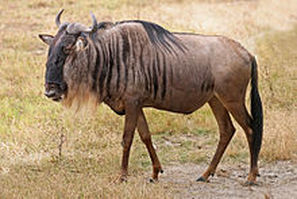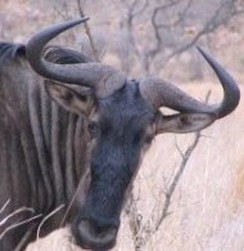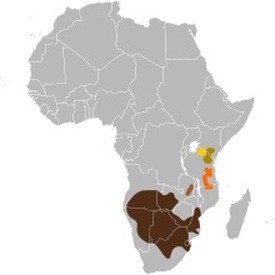Blue WildebeestConnochaetes taurinus |

Custom Search
|
|
The Blue wildebeest (Connochaetes taurinus), or brindled gnu, inhabits a vast area stretching from the central area of the African continent to the southern end of it. They are found on the savannahs of Kenya, Tanzania, Mozambique, Zambia, Zimbabwe, Botswana, South Africa, Namibia and Angola.
It is the most successful animal of the African savannah. There are hundreds of thousands, spread over several countries, and even wars that tormented for decades this area couldn't threaten its survival. The coat is usually gray-silver shade. Under the neck they feature a dense row of hairs, black or white and have a long mane that extends from the neck all the way to the back. The head is large with a black face, the neck is short and the legs are relatively long. The horns bend to the side and up and measure 80 cm in the males, and 30 to 40 cm in females. Wildebeest can measure 2.50 m, having 1.50 m tall and weigh over 250 kg.The shoulders are much higher than the hip. Their life expectancy in the wild is around 20 years. The Blue wildebeests are herbivorous animals and live in large herds, which graze freely on the African Savannah.
They are one of the most desirable prey for lions, hyenas and African wild dogs, but they are also one of the most feared opponents for these predators.
A kick or a hit by the powerful horns can be fatal to the predator, which is why lions respect these animals and, if they are unsuccessful in the initial assault, avoid attacking a second time because they know that the gnu is now in alert state, and that if attacked they will fiercely defend themselves. Predators often choose to watch a herd of black wildebeest and choose those that are most vulnerable, not to take risks. Usually opting for the older animals, the offspring, or attacking those who are injured. The Great Migration of the Serengeti
Every year the wildebeests feel the call of the Great Migration of the Serengeti. When the time comes for this venture, they are joined by the hundreds of thousands even millions and, along with zebras and gazelles, depart for the great journey further north in search of water and greener pastures.
Where they can eat in quantity and better feed their offspring. Along the way there will be many victims, some killed by land predators, others victims of the long journey. When crossing the Grumeti and Mara rivers, the Nile crocodile, alerted by the roar of thousands of animals in approach, is on alert, and the wildebeest sense danger and avoid jumping into the water until the last possible moment. However the pressure exerted on the front animals by those that are behind, is huge, no choice, they must advance, make that jump. So begins the great annual feast for the crocodiles, and soon there hundreds of wildebeest killed. Despite all of these casualties, the Wildebeests are able to keep their population stable, given the reproductive success of the species. Blue Wildebeest - Diet The Blue wildebeest is a herbivorous mammal and feeds mainly on herbaceous like its cousin the Black wildebeest. Blue Wildebeest - Reproduction The females reach sexual maturity at two to three years of age and males from the age of four. During the mating season, which varies with geographic location, the males fight each other to get to form their harems. The gestation period is nine to ten months, after which a calf is born, who is nursed until the age of nine months (possibly until the first year of age). The offspring is able to walk and run soon after birth. This way they can escape from lions and other predators. Black wildebeest - Conservation status and major threats The species is considered as a least concern species according to the International Union for Conservation of Nature. But it is affected by several human-related factors including poaching, large-scale deforestation, the drying up of water sources and the expansion of human settlements.
|
Scientific classification
Kingdom: Animalia Phylum: Chordata Subphylum: Vertebrata Class: Mammalia Order: Artiodactyla Family: Bovidae Subfamily: Alcelaphinae Genus: Connochaetes Species: C. taurinus |


